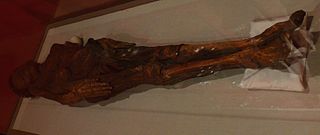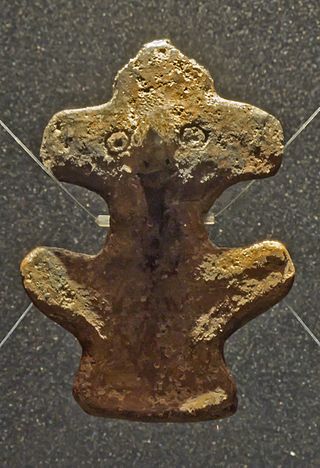Related Research Articles

The Guanches were the indigenous inhabitants of the Canary Islands in the Atlantic Ocean some 100 kilometres (60 mi) west of Africa.

La Gomera is one of Spain's Canary Islands, in the Atlantic Ocean off the coast of Africa. With an area of 370.03 km2 (142.87 sq mi), it is the third-smallest of the archipelago's eight main islands. It belongs to the province of Santa Cruz de Tenerife. La Gomera is the third least populous of the eight main Canary Islands, with 22,426 inhabitants. Its capital is San Sebastián de La Gomera, where the cabildo insular is located.
Guanche is an extinct language that was spoken by the Guanches of the Canary Islands until the 16th or 17th century. It died out after the conquest of the Canary Islands as the Guanche ethnic group was assimilated into the dominant Spanish culture. The Guanche language is known today through sentences and individual words that were recorded by early geographers, as well as through several place-names and some Guanche words that were retained in the Canary Islanders' Spanish.

Juego del palo or banot is a traditional martial art/folk sport of stick-fighting practiced in the Canary Islands. It involves the combative use of a slender stick from 4 to 6 feet long, wielded in both hands, and characterised by fluid motion in attacks and defences.

Candelaria, also Villa Mariana de Candelaria, is a municipality and city in the eastern part of the island of Tenerife in the Province of Santa Cruz de Tenerife, in the Canary Islands, Spain. The city is located on the coast, 17 km southwest of Santa Cruz de Tenerife. The population is 25,140 (2010), and the area is 49.18 km².
Canary Islanders, or Canarians, are a Romance people and ethnic group. They reside on the Canary Islands, an autonomous community of Spain near the coast of northwest Africa, and descend from a mixture of European settlers and aboriginal Guanche peoples. Genetics shows modern Canarian people to be, on average, a population of mostly European ancestry, with some Northwest African admixture. The distinctive variety of the Spanish language spoken in the region is known as habla canaria or the (dialecto) canario. The Canarians, and their descendants, played a major role during the conquest, colonization, and eventual independence movements of various countries in Latin America. Their ethnic and cultural presence is most palpable in the countries of Uruguay, Venezuela, Cuba and the Dominican Republic as well as the U.S. territory of Puerto Rico.

The Virgin of Candelaria or Our Lady of Candle, popularly called La Morenita, celebrates the Virgin Mary on the island of Tenerife, one of the Canary Islands (Spain). The center of worship is located in the city of Candelaria in Tenerife. She is depicted as a Black Madonna. The "Royal Basilica Marian Shrine of Our Lady of Candelaria" is considered the main church dedicated to the Virgin Mary in the Canary Islands and she is the patron saint of the Canary Islands. Her feast is celebrated on February 2 and August 15, the patronal feast of the Canary Islands.

Museo de la Naturaleza y Arqueología (MUNA), is a museum-based in Santa Cruz de Tenerife, Tenerife,. It contains many significant archaeological finds and is considered the best repository of objects from the Pre-Castilian Canary Islands. The museum also houses significant paleontological, botanical, entomological, and marine and terrestrial vertebrate collections, and is considered the best Natural Library of the Canary Islands.

The Mummy of San Andrés is a human mummy belonging to the Guanche culture, who were the ancient inhabitants of the Canary Islands, Spain.

Guayota, in Guanche mythology of Tenerife, was the principal malignant deity and Achamán's adversary.

Guanche mummies are the intentionally desiccated remains of members of the indigenous Berber Guanche people of the Tenerife. The Guanche mummies were made during the eras prior to Spanish settlement of the area in the 15th century. The methods of embalming are similar to those that were used by the Ancient Egyptians, though fewer mummies remain from the Guanche due to looting and desecration.

The Church of the Guanche People is a religious organisation, founded in 2001 in the city of San Cristóbal de La Laguna, Tenerife, Canary Islands, Spain. It aims to perpetuate and spread the traditional religion of the ancient Guanche people.

Guatimac or the Idol of Guatimac is an owl-shaped Guanche cult image, found in 1885, hidden in a cave between the municipalities of Fasnia and Güímar wrapped in goat hide.

Cueva de Achbinico, also called cave of San Blas is a Roman Catholic church and cave located in Candelaria, Tenerife, Canary Islands (Spain).

Cave-Shrine of Chinguaro is a Roman Catholic church and cave located in Güímar on Tenerife. It was the traditional palace of the Guanche King of the Menceyato de Güímar, Acaimo.

Idafe Rock is a natural stone pillar located in Caldera de Taburiente National Park on the island of La Palma in the Canary Islands.
The Cave of the Guanches, or Archaeological area of the Cave of the Guanches, is an important archaeological site located in the north of the island of Tenerife.
The Caves of Don Gaspar is an important archaeological site located in the north of the island of Tenerife.
Antón Guanche was a Guanche aborigine of the island of Tenerife protagonist of the events around the presence among the Guanches of the Christian image of the Virgin of Candelaria before the European conquest of the island.
As in the rest of Spain, the majority religion in the Canary Islands is the Catholic Church. The Catholic religion has been the majority since the Conquest of the Canary Islands in the fifteenth century. This religion would largely replace the Canarian aboriginal religion through the prohibition of the latter and syncretism. According to a survey conducted in 2019, Canary Islands is the fifth autonomous community in Spain with the highest percentage of people who declare themselves to be Catholics after the Region of Murcia, Extremadura, Galicia, Aragon, and Castile and León. 76.7% of the population is Catholic.